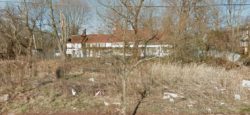
509 Seguine Avenue, Staten Island. Image Credit: Google Maps.
Court ordered owners to secure property from demolition by neglect, authorized Landmarks to take necessary steps if owners fail to comply. The Manee-Seguine Homestead, at 509 Seguine Avenue in Staten Island, was designated an individual City landmark in 1984. The house is one of the few surviving buildings in the Borough and City likely to have been constructed before 1700, with an extension built to the original one-room house in the 18th Century. In September of 2008, Buildings issued an emergency declaration authorizing demolition of the building as unsafe. Landmarks intervened, and the declaration was amended to require that the house be sealed and a perimeter fence installed. In September 2009, Seguine Bay Estates LLC acquired the property.
The owners made little or no repairs to the building, and in October 2013, Buildings issued another order requiring Seguine to make repairs, including the installation of shoring and bracing, and sealing a hole in the roof. The owners failed to comply with the order, and further, sought to stop the City from making repairs under an emergency declaration, for which the City would then bill the owners. Landmarks began an action in Staten Island Supreme Court to compel the owners to protect and repair the property.
Seguine Bay argued that that the building was unsafe and should be demolished, that to maintain the building would be economically unfeasible, and that the property could provide no reasonable rate of return with the landmark standing. The owners claimed they intended to make a hardship application to Landmarks, a procedure by which a building can be demolished or a property redeveloped if the owners demonstrate that it is incapable of generating a reasonable rate of return otherwise. The owners failed to make any repairs or improvements because the structure was so degraded that any such efforts would be useless, and did not justify the expenditure.
Supreme Court Judge Philip S. Straniere found that that Seguine Bay had no intention of engaging in the statutory process to find relief, as the owners had not undertaken any but the most preliminary steps toward engaging in the process during the seven years they had owned the property. Judge Straniere noted that the owner was a sophisticated investor and developer who had known that the property was landmarked when he purchased, and had made a business decision not to engage in the administrative process.
Straniere rejected a takings claim made by Seguine as unripe, finding that the matter could only be adjudicated after the owners had exhausted their administrative remedies through the hardship process. Under the Administrative Code, property owners must maintain a landmarked property while pursuing a hardship application, and by acting unilaterally and a failing their statutory duties by allowing the further degradation of the structure, the owners made themselves subject to potential penalties. He noted that if the structure was unsafe, it was largely the fault of the owners who failed to repair or maintain it.
Straniere granted the City’s request to issue a permanent injunction requiring the owners to cease their demolition through neglect and take steps to secure the property to Landmarks’ satisfaction. Straniere determined that the owners were liable for civil penalties for failing to maintain the property as required by law, and responsible for $5,000 a day from March 2, 2012, until the time that they repair the premises. At the time of the decision, that penalty amounted to $8,550,000.
As the civil penalty limited to the fair market value of a property, with or without improvement, whichever is greater, Straniere ordered parties to reappear before him at a later date to determine the fair market value of the property with and without improvements.
The judge criticized Landmarks for failing to take proactive action to maintain and secure the building, adding that that a boarded-up and fenced-off “eyesore” provided no public benefit despite its age. He urged the parties to find an alternative solution, such as moving the house at the owner’s expense to City-owned property, trading a piece of City-owned property of equal value for the landmarked site, or selling the property to a preservationist organization interested in maintaining it for public use.
In a Law Department press release, Landmarks Chair Meenakshi Srinivasan said the decision “upholds the Landmarks Law and…saves one of the oldest landmarks in New York City.”
City v. Seguine Bay Estates, 2016 N.Y. Slip Op. 51844(U) (S.I.Cty.Sup.Ct. Dec. 29, 2016) (Straniere, J) (Attorneys: Zachary W. Carter, Rachel Moston, Karen Selvin, for City; Howard M. File, for Seguine Bay).

